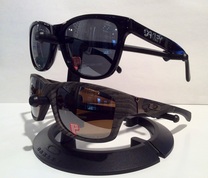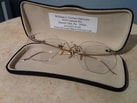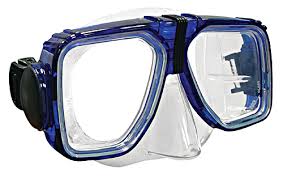
This is the # 1 question that I hear from new customers when they enter our office. It's an important question too! With so many popular frame brands, lens materials, types of lenses, and add-ons, it can be difficult to find a good price on quality eyewear, especially when you see all of these too-good-to-be-true deals advertised on TV commercials and websites. That being said, let me break down the general ideal price when it comes to quality eyewear.

I've often seen eyewear advertised on websites and TV commercials for less than $100.00 (I've even seen a full set of eyewear advertised for $69.00). My wholesale price just for a frame is much more than $69.00!! So, how are these places having these "great" deals. Usually when you come across a too-good-to-be-true deal, it usually is! For those that do get tricked into these gimmicks, they usually end up paying more out of pocket and go through more frames due to breakage that's caused by low quality materials and poor professional services. This will then lead to headaches that will cause customers to become dissatisfied and hesitant about future eyewear purchases.
Key Points to Remember:
When it comes to purchasing eyewear, a customer must consider quality above all!
I usually tell my customers that buying cheap eyewear is like buying cheap shoes. They may look nice, but they will become uncomfortable to wear, and they won't last long. If you want your eyewear to fit well and last longer, then I recommend visiting a local certified Optician, that will offer wonderful customer service and quality eyewear for a great price!
When it comes to purchasing eyewear, a customer must consider quality above all!
I usually tell my customers that buying cheap eyewear is like buying cheap shoes. They may look nice, but they will become uncomfortable to wear, and they won't last long. If you want your eyewear to fit well and last longer, then I recommend visiting a local certified Optician, that will offer wonderful customer service and quality eyewear for a great price!
Generic Price Guide!
Frame - A good quality frame will cost at least $100.00

I recommend a frame that is made out of either Titanium or Stainless Steel. Not only will these types of frame materials hold together for a number of years, they are also nickel free! Individuals can suffer from an allergic reaction because of nickel found in other types of metal frames in today's optical market.
Other types of frame materials include: Carbon Fiber, Nylon, Aluminium, Optyl, and more! Many frame companies have their own trademark materials that are exclusive to them. These trademark frame materials have their own advantages and disadvantages in my opinion. Also, keep in mind that when you see a frame that is a few hundred dollars, you are buying the brand from that particular company and (or) the characteristic of the frame itself (ex: Wood, Full Titanium Rimless).
Note: We recommend rimless eyewear for children. Too many Opticians force fit a small adult frame on kids and not only does it not fit but it looks terrible. Also, the rimless frame can grow with the child!!
Lens Materials:
(These materials are available for each type of lenses: Single Vision, Bi-Focals/Tri-Focals and Progressives. Lens materials are limited to certain Rx specifications and lens add-ons)
-Glass
-CR-39
-Polycarbonate
-Trivex
-Hi-Index
Glass - Rarely used in today's Rx lenses. Glass is thick, heavy, and prone to serious eye injuries if lenses shatter.
CR-39 (Plastic) - The material is most commonly used in today's market. It is about half the weight of glass and equal in safety to a chemically treated lens. Does not fog as easily as glass. Lens is porous so it is easily dyed. Scratch coatings can be applied. Index is 1.498.
Polycarbonate - This material is considered to be "soft" which results in an extremely high impact resistance lens. Blocks harmful UVA and UVB light rays. Requires an anti-scratch coating which makes it difficult to dye. This is the safest material available and all patients should be told before purchase (Duty to Warn). This lens material can have a center thickness of 1.0, this reduces thickness and weight. Index is 1.586.
Trivex - This material was originally developed by the US military and used for their helicopter windshields. Blocks harmful UVA and UVB light rays. Impact resistance comparable to Polycarbonate. Considered best for drill mounts because of minimal internal stress. About 20% lighter than CR-39 and can be made thin. Takes well to tinting. Index is 1.53.
High Index Plastic - This material will reduce the thickness and weight when used in lenses with high powers. Index varies from 1.67 and up.
Types of Lenses:
Single Vision Lenses (Low Power) Typical Range: $110-$170
Bi-Focals/Tri-Focals Lenses - Typical Range $200-$250
Progressive Lenses - Typical Range $300+
Enhancements:
High Definition Lenses are available for Single Vision Lenses, Bifocals/Tri-Focals and Progressives. The price is usually $100-$200 extra. HD Lenses are more exact when it comes to optics and better vision when it comes to stronger prescriptions.
Lens Add-Ons:
Anti-Reflective Coating (also known as A/R Coating).
Here are a few benefits of A/R Coating:
Cheaper low-quality Anti-Reflective Coating are extremely difficult to clean, and can crack or peal over a short period of time!
We recommend Crizal® Anti-Reflective Coating to all of our patients. We trust this product so much that it automatically comes with a 2 year customer satisfaction guarantee. Once you order a pair of lenses with A/R Coating, you will never go back to ordinary lenses.
Three Tiers of Crizal® A/R Coating:
Tier 1: Alize: $
Tier 2: Avance $$
Tier 3: Prevencia: $$$
Note: The product becomes better based on each tier level. However, the price increases accordingly.
Other types of frame materials include: Carbon Fiber, Nylon, Aluminium, Optyl, and more! Many frame companies have their own trademark materials that are exclusive to them. These trademark frame materials have their own advantages and disadvantages in my opinion. Also, keep in mind that when you see a frame that is a few hundred dollars, you are buying the brand from that particular company and (or) the characteristic of the frame itself (ex: Wood, Full Titanium Rimless).
Note: We recommend rimless eyewear for children. Too many Opticians force fit a small adult frame on kids and not only does it not fit but it looks terrible. Also, the rimless frame can grow with the child!!
Lens Materials:
(These materials are available for each type of lenses: Single Vision, Bi-Focals/Tri-Focals and Progressives. Lens materials are limited to certain Rx specifications and lens add-ons)
-Glass
-CR-39
-Polycarbonate
-Trivex
-Hi-Index
Glass - Rarely used in today's Rx lenses. Glass is thick, heavy, and prone to serious eye injuries if lenses shatter.
CR-39 (Plastic) - The material is most commonly used in today's market. It is about half the weight of glass and equal in safety to a chemically treated lens. Does not fog as easily as glass. Lens is porous so it is easily dyed. Scratch coatings can be applied. Index is 1.498.
Polycarbonate - This material is considered to be "soft" which results in an extremely high impact resistance lens. Blocks harmful UVA and UVB light rays. Requires an anti-scratch coating which makes it difficult to dye. This is the safest material available and all patients should be told before purchase (Duty to Warn). This lens material can have a center thickness of 1.0, this reduces thickness and weight. Index is 1.586.
Trivex - This material was originally developed by the US military and used for their helicopter windshields. Blocks harmful UVA and UVB light rays. Impact resistance comparable to Polycarbonate. Considered best for drill mounts because of minimal internal stress. About 20% lighter than CR-39 and can be made thin. Takes well to tinting. Index is 1.53.
High Index Plastic - This material will reduce the thickness and weight when used in lenses with high powers. Index varies from 1.67 and up.
Types of Lenses:
Single Vision Lenses (Low Power) Typical Range: $110-$170
Bi-Focals/Tri-Focals Lenses - Typical Range $200-$250
Progressive Lenses - Typical Range $300+
Enhancements:
High Definition Lenses are available for Single Vision Lenses, Bifocals/Tri-Focals and Progressives. The price is usually $100-$200 extra. HD Lenses are more exact when it comes to optics and better vision when it comes to stronger prescriptions.
Lens Add-Ons:
Anti-Reflective Coating (also known as A/R Coating).
Here are a few benefits of A/R Coating:
- See Better: Reduce glare for safer nighttime driving
- Look Better: people see you and not your lenses. (lenses look invisible instead of having a whitish reflection)
- Feel Better: fewer headaches and less eye fatigue
Cheaper low-quality Anti-Reflective Coating are extremely difficult to clean, and can crack or peal over a short period of time!
We recommend Crizal® Anti-Reflective Coating to all of our patients. We trust this product so much that it automatically comes with a 2 year customer satisfaction guarantee. Once you order a pair of lenses with A/R Coating, you will never go back to ordinary lenses.
Three Tiers of Crizal® A/R Coating:
Tier 1: Alize: $
Tier 2: Avance $$
Tier 3: Prevencia: $$$
Note: The product becomes better based on each tier level. However, the price increases accordingly.
Transitions - Average Add-On Price $100
Transition lenses darken in UV light and become clear indoors. Different types of Transition lenses are available.
Transitions® Signature™
Note: This new product replaced the traditional Transition® VI Lenses
Benefits: "Lenses are more responsive in both direct and indirect sunlight, which means they get darker when facing away from the sun, in reflected light and at different times of the day; many of the outdoor conditions that wearers commonly encounter." Summary: The lenses are completely clear indoors and become even darker outdoors than compared to other previous Transitions® lenses in direct sunlight. The Signature™ VII lenses are more responsive in hot temperatures, geological location, weather conditions and the wearers daily lifestyle.
Other benefits include: fast fade back speed and 100% Blockage from harmful UVA and UVB light rays. Colors: Gray, Brown, & Graphite Green
Transitions® XTRActive™ These lenses have a slight tint indoors and turn even darker than the regular Transitions® lenses (except for the Signature VII Series)
They block 100% UVA and UVB rays.
Available colors: Gray
Transitions® Vantage™These lenses have a slight tint indoors and turn dark outdoors. Not only do they darken, but they become polarized which will reduce glare and enhance vision. These lenses also work well with individuals who are light sensitive indoors and outdoors.
They block 100% of UVA and UVB rays.
Available color: Gray
Transition lenses darken in UV light and become clear indoors. Different types of Transition lenses are available.
Transitions® Signature™
Note: This new product replaced the traditional Transition® VI Lenses
Benefits: "Lenses are more responsive in both direct and indirect sunlight, which means they get darker when facing away from the sun, in reflected light and at different times of the day; many of the outdoor conditions that wearers commonly encounter." Summary: The lenses are completely clear indoors and become even darker outdoors than compared to other previous Transitions® lenses in direct sunlight. The Signature™ VII lenses are more responsive in hot temperatures, geological location, weather conditions and the wearers daily lifestyle.
Other benefits include: fast fade back speed and 100% Blockage from harmful UVA and UVB light rays. Colors: Gray, Brown, & Graphite Green
Transitions® XTRActive™ These lenses have a slight tint indoors and turn even darker than the regular Transitions® lenses (except for the Signature VII Series)
They block 100% UVA and UVB rays.
Available colors: Gray
Transitions® Vantage™These lenses have a slight tint indoors and turn dark outdoors. Not only do they darken, but they become polarized which will reduce glare and enhance vision. These lenses also work well with individuals who are light sensitive indoors and outdoors.
They block 100% of UVA and UVB rays.
Available color: Gray
Sunglasses - Polarized lenses are $100.00 average add-on. These lenses are great for driving and enjoying the outdoors. The are also highly fashionable for social events/activities!
Tints - $30 - 50 Extra. Lenses are dyed to the individual's desired color. Many colors are available to choose from either for fashion or for color contrast in sports. Tinting lenses can also be used for those that are extremely light sensitive.
Mirror Coating - $80 - $100 Extra
This coating reflects its image back, just like an actual mirror.
Mirror Coating - $80 - $100 Extra
This coating reflects its image back, just like an actual mirror.
Pinstripe - $49 Extra
(Exclusive Only at Curran Opticians for Full Rimless Eyewear)
We groove the outside of the lenses and we use a special tip pen to color the groove.
(Exclusive Only at Curran Opticians for Full Rimless Eyewear)
We groove the outside of the lenses and we use a special tip pen to color the groove.
Opti-Fog - $180 - $220 Extra
Eliminates unwanted fog on lenses. Great for those that enjoy skiing, snowboarding, or swimming.
Sun Clip-Ons - $59 - $99 Extra
Only available for certain frames. Sun clips are polarized and they offer an alternative to buying an extra pair of sunglasses if the customer already has a clear pair of eyewear.
Eliminates unwanted fog on lenses. Great for those that enjoy skiing, snowboarding, or swimming.
Sun Clip-Ons - $59 - $99 Extra
Only available for certain frames. Sun clips are polarized and they offer an alternative to buying an extra pair of sunglasses if the customer already has a clear pair of eyewear.
We Offer Other Specialty Lenses: Computer/Music/TV Eyewear, Custom Lens Shapes, Sun Clips, Vintage Eyewear, Billiard Eyewear, Rx Swim Masks/Goggles, Safety Frames, Custom Made Fitovers, and more!
We would like to hear from you. Please feel free to leave a comment or ask us a question!




















